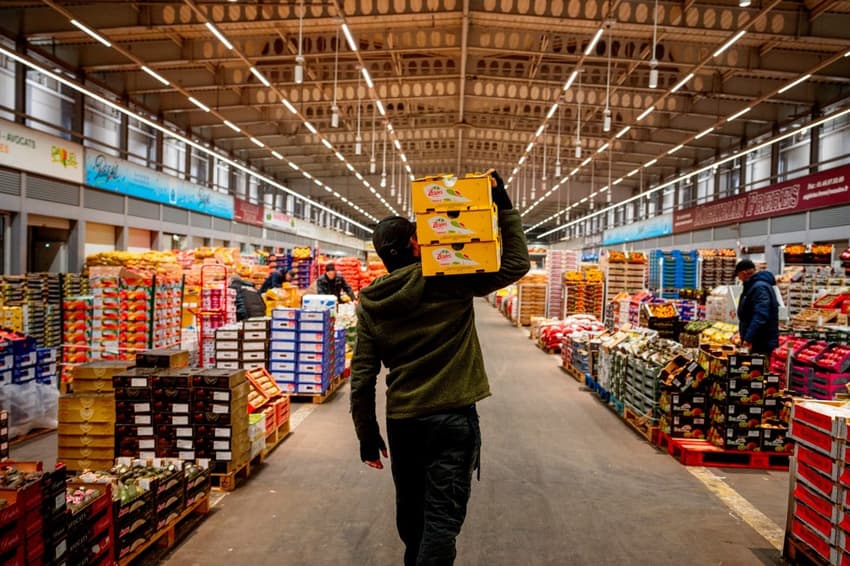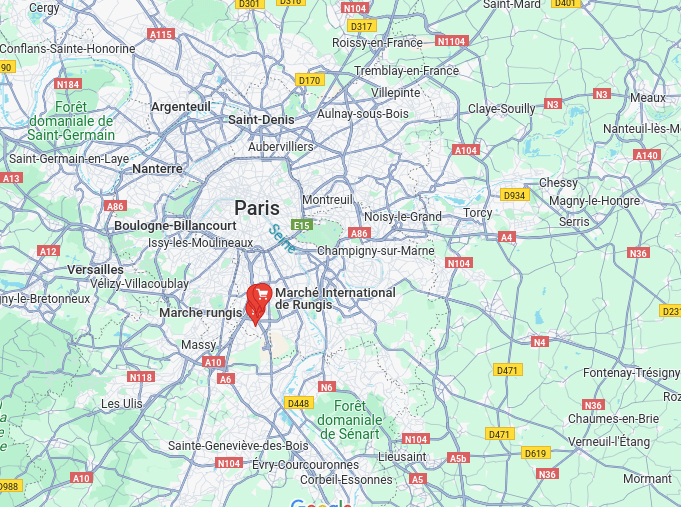'The belly of Paris' - what is Rungis and why are French farmers protesting there?

French farmers are threatening to blockade Rungis - but what exactly is this and why is it so important to Paris?
It's one of the most important places in France, so famous that it’s routinely referenced by a single word: Rungis.
On Friday French farmers threatened to block it, potentially disrupting food supplies to the capital.
Its full name is Marché International de Rungis, and even that doesn’t do it complete justice to the world’s largest wholesale fresh produce market, providing employment for more than 12,000 people and business for more than 1,200 firms.
The site covers 234 hectares and is, to all intents and purposes, the Pantry of Paris - or Le ventre de Paris (the belly of Paris) as writer Emile Zola nicknamed it.
It’s where wholesalers and restaurateurs stock up on fruit, vegetables, meat, fish and dairy products.
The market is open from 2am, six days a week, and supplies daily fresh food produce for a quarter of the population of France.
Waste from the market is recycled and energy generated by the incinerator is used to heat the market and nearby Orly Airport.
Its current location is about 20km south of Paris, if you have driven south out of the city you will certainly have seen signs to it.

It opened in its current location in 1969 – but its history dates back more than 1,000 years in Paris.
The first known sketches of a major food market in Paris – Marché Palu – were drawn in the fifth century. Unsurprisingly, that was located on the Île de la Cité. It later moved to Place de Grève, which is today more famous as Hotel de Ville.
In 1135, it moved again, this time to Les Champeaux, a commercial area at the crossroads of Rue Saint-Honoré, Rue Montmartre and Rue Saint-Denis.
Its history here is established in the area’s new name: Les Halles, which is now a largely underground shopping mall near the central Metro station of very similar name. Emile Zola coined its nickname in his 1873 novel Le Ventre de Paris, which is set in the busy marketplace.
Les Halles remained open until 1973, but it had been known for more than two decades that it was too small to serve the needs of the rapidly expanding population in Paris and Île-de-France.
In 1959, the town of Rungis, on the outskirts of the capital, was chosen as the venue for what would become the Marché International de Rungis. It opened a decade later – despite objections from food merchants in Paris, who did not like the idea of travelling from the city centre.
The market was inaugurated on March 3rd, 1969, after a four-day relocation operation dubbed the “déménagement du siècle” (moving of the century). Almost 30,000 people, 1,500 transport vehicles, and 400 removal lorries were involved in the operation, and the army was brought in to oversee the move, which caused severe disruption in Paris for several days.
Rungis does have another, slightly grim, distinction. Its large site with many refrigerated areas means that it serves as an emergency overflow morgue for the city of Paris.
Some bodies were stored on the site after the heatwave of 2003 in which 15,000 people - many of them elderly and living alone - died.
During the first wave of the Covid pandemic in 2020 space was readied at Rungis to store bodies, but in the event it was not needed and the city's morgues coped.
Comments
See Also
It's one of the most important places in France, so famous that it’s routinely referenced by a single word: Rungis.
On Friday French farmers threatened to block it, potentially disrupting food supplies to the capital.
Its full name is Marché International de Rungis, and even that doesn’t do it complete justice to the world’s largest wholesale fresh produce market, providing employment for more than 12,000 people and business for more than 1,200 firms.
The site covers 234 hectares and is, to all intents and purposes, the Pantry of Paris - or Le ventre de Paris (the belly of Paris) as writer Emile Zola nicknamed it.
It’s where wholesalers and restaurateurs stock up on fruit, vegetables, meat, fish and dairy products.
The market is open from 2am, six days a week, and supplies daily fresh food produce for a quarter of the population of France.
Waste from the market is recycled and energy generated by the incinerator is used to heat the market and nearby Orly Airport.
Its current location is about 20km south of Paris, if you have driven south out of the city you will certainly have seen signs to it.

It opened in its current location in 1969 – but its history dates back more than 1,000 years in Paris.
The first known sketches of a major food market in Paris – Marché Palu – were drawn in the fifth century. Unsurprisingly, that was located on the Île de la Cité. It later moved to Place de Grève, which is today more famous as Hotel de Ville.
In 1135, it moved again, this time to Les Champeaux, a commercial area at the crossroads of Rue Saint-Honoré, Rue Montmartre and Rue Saint-Denis.
Its history here is established in the area’s new name: Les Halles, which is now a largely underground shopping mall near the central Metro station of very similar name. Emile Zola coined its nickname in his 1873 novel Le Ventre de Paris, which is set in the busy marketplace.
Les Halles remained open until 1973, but it had been known for more than two decades that it was too small to serve the needs of the rapidly expanding population in Paris and Île-de-France.
In 1959, the town of Rungis, on the outskirts of the capital, was chosen as the venue for what would become the Marché International de Rungis. It opened a decade later – despite objections from food merchants in Paris, who did not like the idea of travelling from the city centre.
The market was inaugurated on March 3rd, 1969, after a four-day relocation operation dubbed the “déménagement du siècle” (moving of the century). Almost 30,000 people, 1,500 transport vehicles, and 400 removal lorries were involved in the operation, and the army was brought in to oversee the move, which caused severe disruption in Paris for several days.
Rungis does have another, slightly grim, distinction. Its large site with many refrigerated areas means that it serves as an emergency overflow morgue for the city of Paris.
Some bodies were stored on the site after the heatwave of 2003 in which 15,000 people - many of them elderly and living alone - died.
During the first wave of the Covid pandemic in 2020 space was readied at Rungis to store bodies, but in the event it was not needed and the city's morgues coped.
Join the conversation in our comments section below. Share your own views and experience and if you have a question or suggestion for our journalists then email us at [email protected].
Please keep comments civil, constructive and on topic – and make sure to read our terms of use before getting involved.
Please log in here to leave a comment.